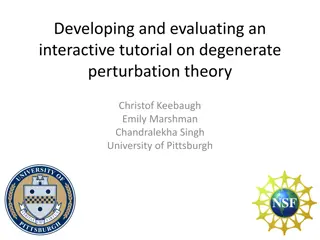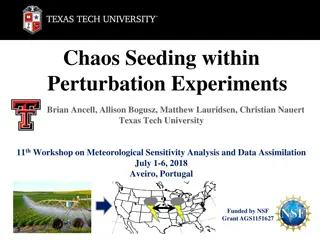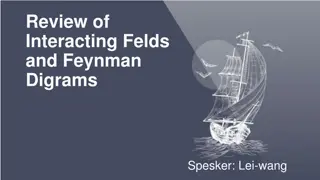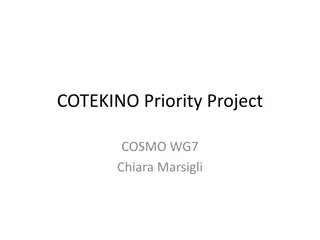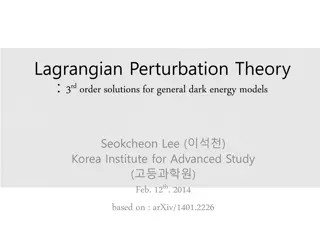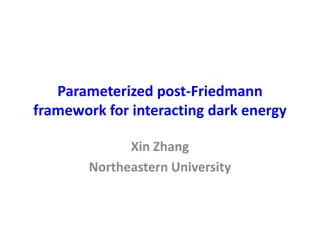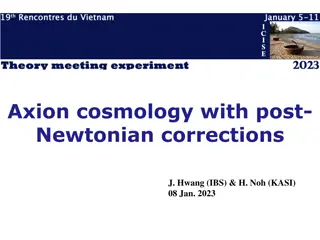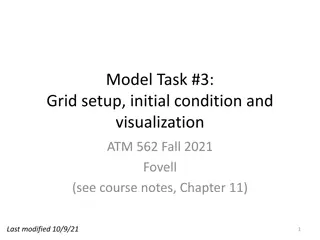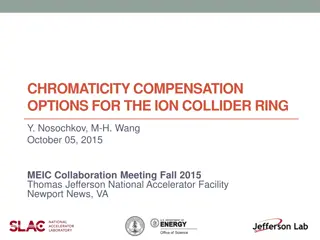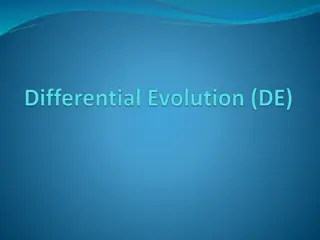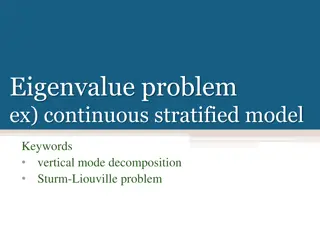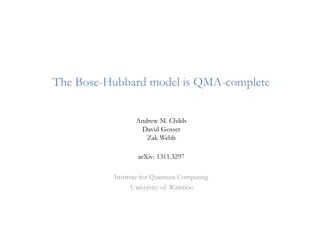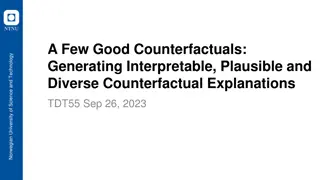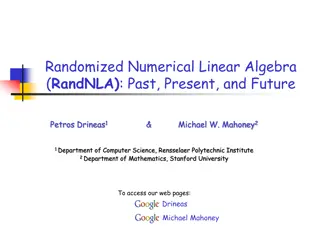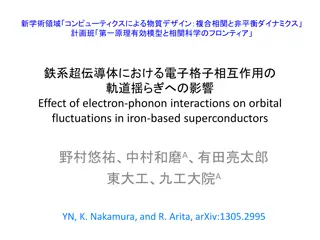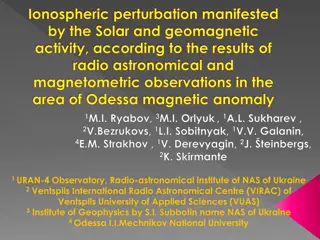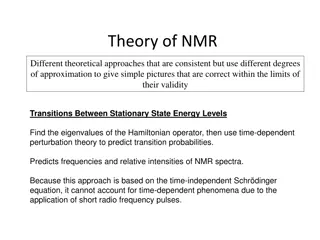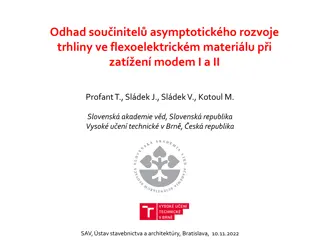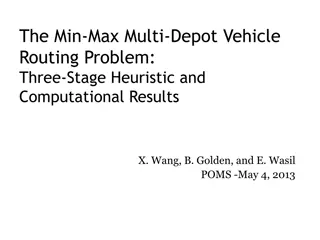Earth-GRAM Overview and Updates 2023
Earth-GRAM is a global reference atmospheric model providing monthly mean and standard deviation data for various atmospheric variables. It is used in engineering for dispersion simulations but is not a forecasting model. Updates to Earth-GRAM include the Modern Era Retrospective Analysis, a global
0 views • 19 slides
Understanding Feynman Diagrams in Particle Physics
Feynman diagrams, developed by Richard Feynman in the 1940s, are a graphical technique to represent particle interactions in space-time. These diagrams use lines to depict particles, with fermions moving forward in time and antifermions moving backward. Vertices in the diagrams represent points wher
1 views • 19 slides
Interactive Tutorial on Degenerate Perturbation Theory: QuILT Development and Student Difficulties
Developing an interactive tutorial on Degenerate Perturbation Theory (DPT) to aid students in understanding the challenging synthesis of Quantum Mechanics concepts with Linear Algebra. The tutorial focuses on addressing common student difficulties, such as identifying good bases, diagonalizing matri
0 views • 12 slides
Understanding Time-Independent Perturbation Theory in Quantum Mechanics
Perturbation theory is a powerful tool in solving complex physical and mathematical problems approximately by adjusting solutions from a related problem with known solutions. This theory allows for more accurate approximate solutions by treating the difference as a small perturbation. An example inv
0 views • 19 slides
Investigating Chaos Seeding in Perturbation Experiments
This research project conducted at Texas Tech University delves into the effects of chaos seeding within perturbation experiments on atmospheric conditions, with a focus on local and nonlocal modifications resulting from factors such as irrigation, wind farms, and urban development. By analyzing tin
0 views • 24 slides
Understanding Interacting Fields and Feynman Diagrams in Quantum Field Theory
Delve into the fascinating world of quantum field theory with a focus on interacting fields and Feynman diagrams. Explore perturbation theory, correlation functions, Wick's theorem, and Feynman diagram rules to gain insights into preserving causality, calculating two-point correlation functions, and
0 views • 18 slides
COTEKINO Priority Project Summary
COTEKINO Priority Project involved developing and testing perturbation methodologies for convection-permitting ensembles across various operational weather services. Tasks included deriving perturbations, testing models, and coordinating with different agencies. The project aimed to enhance forecast
0 views • 9 slides
Lagrangian Perturbation Theory: Applications in Cosmology
Lagrangian Perturbation Theory (LPT) offers solutions for general dark energy models and is crucial for upcoming large-scale surveys. It provides a method to displace particles at large scales efficiently. While Standard Perturbation Theory (SPT) is limited at linear order, LPT overcomes its drawbac
0 views • 14 slides
Exploring Parameterized Post-Friedmann Framework for Interacting Dark Energy
Dive into the complexities of considering interacting dark energy (IDE) using a parameterized post-Friedmann framework. Learn why IDE is essential, how to detect couplings, calculate perturbation evolutions, and address instability issues. Explore the one-parameter extensions like wCDM and I.CDM, an
0 views • 18 slides
Understanding Axion Cosmology with Post-Newtonian Corrections
Exploring axion cosmology with post-Newtonian corrections, this study delves into linear density perturbations for dust, the role of axion as a cold dark matter candidate, and fully nonlinear perturbation formulations. It addresses continuity, momentum conservation, and quantum stress to identify ke
0 views • 22 slides
Atmospheric Modeling Task with Initial Conditions and Grid Setup
Create a model grid with 2D arrays for prognostic variables, set initial dry and adiabatic environmental conditions, introduce thermal and pressure perturbations, and visualize using GrADS. Define variables like velocities, perturbation temperature, and pressure fields, along with base state variabl
0 views • 27 slides
Chromaticity Compensation Options for the Ion Collider Ring
The MEIC Interaction Region faces challenges due to high beta functions causing chromatic perturbation. To address this, local compensation through Chromaticity Compensation Block (CCB) with sextupoles is proposed. Three CCB options are presented for consideration. The report explores the impact of
0 views • 17 slides
Understanding Differential Evolution: An Overview of the DE Algorithm
Differential Evolution (DE) is an Evolutionary Algorithm (EA) proposed for continuous function optimization. It uses vector differences to perturb the population, deviating from traditional crossover and mutation methods. DE involves mutation, perturbation, and various mutation schemes like DE/rand/
0 views • 20 slides
Governing Equations and Model Reduction in Continuous Stratified Models
Detailed analysis of the governing equations in a continuous stratified model with vertical mode decomposition and Sturm-Liouville problem. The density perturbation and pressure perturbation are examined to derive a reduced 3D system. The Boussinesq approximation and hydrostatic balance are applied,
0 views • 36 slides
Understanding Computational Complexity in Quantum Hamiltonians
The Bose-Hubbard model is proven to be QMA-complete, indicating the challenge in solving ground energy problems in quantum systems. Various classes of Hamiltonians, such as k-local and stoquastic, exhibit different complexities in computing ground energy. While some systems with QMA-complete ground
0 views • 40 slides
Enhancing Counterfactual Explanations for Improved Understanding
This article explores the concept of generating interpretable, diverse, and plausible counterfactual explanations within explainable AI (XAI). It highlights the challenges with current methods, introduces an instance-guided approach, and emphasizes the importance of good counterfactuals. The discuss
0 views • 22 slides
Exploring Randomized Numerical Linear Algebra (RandNLA)
Delve into the world of RandNLA, where randomization and sampling techniques are utilized to design accurate algorithms for handling massive matrices and computationally complex problems. Learn about sampling rows/columns, matrix perturbation theory, and its applications in Big Data, theoretical com
0 views • 83 slides
Understanding Degenerate Perturbation Theory in Quantum Mechanics
Exploring time-independent perturbation theory, specifically focusing on non-degenerate and degenerate spectra. The lecture covers approximation schemes, treatment of multi-electron atom term values, and the effects of spin-orbit interaction. Concepts include evaluating expectation values, wavefunct
0 views • 13 slides
Understanding Electron-Phonon Interactions in Iron-Based Superconductors
This discussion explores the effects of electron-phonon interactions on orbital fluctuations in iron-based superconductors. Topics covered include ab initio downfolding for electron-phonon coupled systems, evaluation methods such as Constrained Random Phase Approximation (cRPA), Constrained Density-
0 views • 12 slides
Study on Ionospheric Perturbation Due to Solar and Geomagnetic Activity in Odessa Magnetic Anomaly
Research conducted in the area of the Odessa magnetic anomaly investigates ionospheric perturbations caused by solar and geomagnetic activity. The study utilizes radio astronomical and magnetometric observations from various observatories, highlighting the significance of the geomagnetic anomaly nea
0 views • 18 slides
Insights into Theoretical Approaches in NMR Spectroscopy
Theoretical approaches in NMR spectroscopy encompass diverse methods, each with varying degrees of approximation but yielding correct results within their validity. Techniques such as transition probabilities using the time-dependent perturbation theory, Zeeman interaction for energy level transitio
0 views • 32 slides
Understanding Flexoelectric Materials and Their Asymptotic Behavior in Crack Development
Explore the utilization of asymptotic approaches to analyze crack development in flexoelectric materials, considering the influence of intensity of applied stress, limitations, advantages, and the connection to singular perturbation methods. Discover the intriguing property of flexoelectric material
0 views • 17 slides
Heuristic Approach for the Min-Max Multi-Depot Vehicle Routing Problem
This study explores a three-stage heuristic to solve the Min-Max Multi-Depot Vehicle Routing Problem (MDVRP), aiming to minimize the maximum distance traveled by vehicles. It covers an introduction to the problem, literature review, the importance of the min-max objective, and a heuristic solution m
0 views • 21 slides


